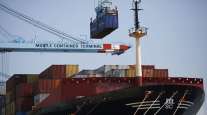Truck-Rail Shipments Rise in 2nd Quarter, IANA Says
By Michael G. Malloy, Staff Reporter
This story appears in the Aug. 11 print edition of Transport Topics.
Intermodal volume rose 8.2% in the second quarter from a year earlier, an indication the industry is recovering from the double blow it took from a harsh winter and contracted economy, the Intermodal Association of North America reported last week.
Truck-rail shipments totaled 4.17 million units, led by international containers, which jumped 9.6% to 2.13 million, according to IANA’s quarterly report released Aug. 4.
Domestic container shipments rose 7.6% to 1.63 million units, while trailer shipments rose 4.3% to 414,357, the report said.
The overall business accelerated from the first quarter, which totaled 3.77 million units.
“The results were indicative of a rebounding economy and higher-than-predicted import shipments,” IANA President Joni Casey said. “It is also probable the harsh winter that resulted in constricted first-quarter capacity contributed to the second quarter’s strong growth.”
Casey told Transport Topics that some of the quarter’s strength could be attributed to some shippers’ rerouting some freight to the East Coast, citing concerns about labor negotiations between West Coast dockworkers and port terminals.
As of late last week, that matter remained unresolved. The six-year labor contract expired at the end of June, though operations are continuing.
Intermodal marketing companies posted growth rates that were more modest than the overall volume, up 2.4% over last year, IANA said.
Average revenue for both rail intermodal and highway segments continued strong growth, with increases of 6% and 16.3%, respectively. Like much of the broader market, companies in part benefited from the robust showing from imports based on transloading opportunities, the report said.
The Southeast intermodal corridor posted the highest growth rate, at 12.9%, but had the lowest overall total at just over 200,000 shipments.
The Midwest-Southwest corridor had the largest volume, at more than 750,000, an 8.6% increase.
“It could be an indicator of advanced shipments that are circumventing the West Coast and coming in through Panama or Suez [canals] into the East Coast,” Casey said. “Our typical [shipment] peak is August through October and into November,” in advance of the year-end holiday shopping season.
“There is certainly speculation whether or not that has shifted earlier,” Casey told TT. “I think it’s too early to [determine that] or if the high level of imports that have been coming in are a hedge against the labor dispute.”
“The third quarter is historically the strongest quarter and has been characterized as peak,” she added, “so there’s been a lot of speculation whether that has shifted to the second quarter — or even the end of the first quarter.”
Container imports through the ports of Los Angeles and Long Beach, California, leapt 9.8% from the previous year, IANA said, noting that “gains may have been even stronger for other port regions: Both the port of Norfolk [Virginia] and the port of Charleston [South Carolina] saw double-digit import increases.”
Domestic containers from the Northeast to the Midwest rose by a “striking 15.2%, with overall domestic shipments growing by 8.5% in this lane,” the report noted. International intermodal improved but brought down the corridor’s overall average to 7.4% for the quarter.
Highway volume recorded another negative quarter, though that sector fell much less than in the first quarter, dipping 0.5% compared with 5.9%.
“One bright spot, however, was a different monthly pattern than intermodal,” the report said. “Highway volume increased from month to month, and June saw the highest loads since last year’s October peak.
“This might point to highway getting back on track for growth in the third quarter, also reflected by the 11.2% quarter-over-quarter leap,” IANA said. “The big question will be whether there is sufficient trucking capacity for [intermodal companies] to grow their highway segment.”
Recent earnings reports showed stronger intermodal results at transportation firms.
Norfolk Southern Corp.’s intermodal revenue jumped 11% to a record $650 million, and its volume also rose 11%. Intermodal revenue increased 1% to $456 million, while C.H. Robinson’s intermodal net revenue rose 9.5%.




